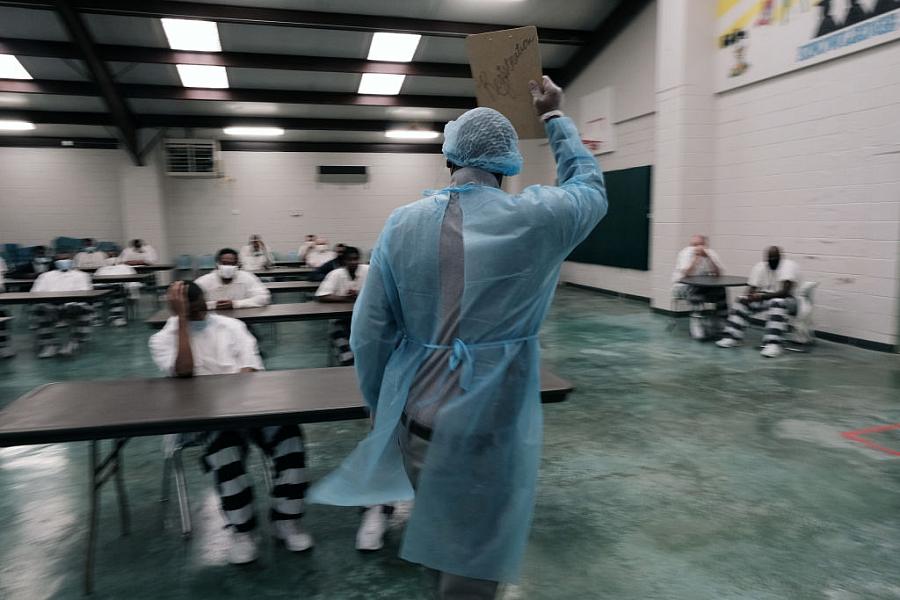I needed a statistics Ph.D. to do my original story on health care in jails. Luckily I found another way

Photo by Spencer Platt/Getty Images
When I first set out to write a story about Wellpath, a controversy-ridden conglomerate rapidly taking over California’s jail health care system, I was a brand-new data reporter with a rosy vision of what data could do. I had pitched a story examining death rates across California jails, hoping to answer the question of whether jails managed by Wellpath, a private company, had worse health care outcomes than publicly managed ones. And I had hypothesized that I would end up with straightforward data-driven findings showing that Wellpath had higher death rates.
But after several months of reporting, I learned that my initial vision of the story wouldn’t be possible. I’d spoken with dozens of experts, including jail health care professionals who specialized in analyzing data on jail health care outcomes. Most of them told me that what I was attempting to do would be challenging for someone with a Ph.D. in statistics, let alone a data journalist with dozens of other stories to balance over the year.
That’s because health care outcomes in jails, as in hospitals, are impacted by what public health experts call “social determinants of health.” Jail populations in different U.S. counties are impacted differently by elements including racism, poverty and even environmental pollution, which could impact death rates in a way that obscures the impact of privatization.
For instance: A jail in McDowell County, West Virginia, which has the nation’s highest overdose death rate, may look like it treats its patients worse than a jail in Ellis County, Texas, which has one of the nation’s lowest overdose death rates. Additionally, jails don’t just have health care providers; they also have correctional officers, which can neglect or abuse people in their facilities, contributing to changing death rates. To untangle all of these confounding variables, I’d need far more data than I had access to in the public record — health data that a scrutinized private company would almost certainly refuse to hand over.
I spoke with my National Fellowship advisor and probed the sources I’d cultivated, including patients within Wellpath-managed jails, and an alternative angle emerged. I would focus the story on a single person — a man named Sergio Guzman Gonzalez, who died of COVID-19 in a Wellpath jail — and use his experience and his family’s legal claim against the county to tell a story about Wellpath as a company that had repeatedly been accused of failing to provide timely medical aid to prisoners in its care, people who were “literally a captive market,” as one expert said.
I revised my original outline and got to work, visiting with Gonzalez’ family members, requesting dozens of public records from the Monterey County Jail, and speaking with numerous attorneys involved in suing the county for its poorly run jail health care system. I submitted a draft of my story late in the year, but was hoping it would still be able to run sometime in the first month of January 2022.
The story wasn’t published in January 2022. Due to a mix of other demands on my time, shifting editors on the project, and those editors’ shifting views about what the story should be, my project was published a full year and a half after I’d originally promised to deliver it. The waiting and revision process was painful, both for me and for the family I had interviewed. I felt guilty about making them (and the fellowship coordinators) wait for the piece for so long.
But when the story finally published, I was relieved and proud I’d seen it through. Even though editors had decided the story would no longer focus on Gonzalez’ death, we still included his story and the beautiful photos our photographer had taken of his family, and they thanked me for writing the piece and raising awareness about what had happened to their son. We mailed them copies of the print edition it appeared in, which had beautiful images of their son’s grave and memorial.
The story has since been referenced in news stories and newsletters by The Guardian, the Santa Rosa Press Democrat, CalMatters, Politico and other publications. Jail health care advocates and Chronicle readers thanked me for shining a spotlight on Wellpath’s gradual takeover of the state’s jail health care system, and multiple attorneys told me my work would inform their ongoing lawsuits against Wellpath. Two months after it was published, I learned that a judge overseeing a lawsuit against the Monterey County Jail found Wellpath to be out of compliance with 43 requirements related to medical and mental health care, ordering the company to comply within six months or face a fine of up to $1 million.
These signs tell me that while my story didn’t singlehandedly fix California’s jail health care system, it appears to be filtering upward to people with the power to do something about regulating the company’s growth and improving enforcement so it can be held liable when it violates patients’ civil rights. At the very least, it’s added to a mounting body of evidence showing that privatization in health care can lead to negative outcomes, both in and outside of jails.
I learned a lot from my experience. In every ambitious data-driven reporting project I’ve embarked on since, I’ve consulted with data experts before I outline and pitch the piece. You never know what kind of advice will allow you to shape your story earlier on and save lots of time. But I also learned that no matter what, almost any story is salvageable given enough time and the right editors. The piece may not look the way you’d originally anticipated, but the right human beings, an accountability mindset and doggedness will get you to the finish line every time.

